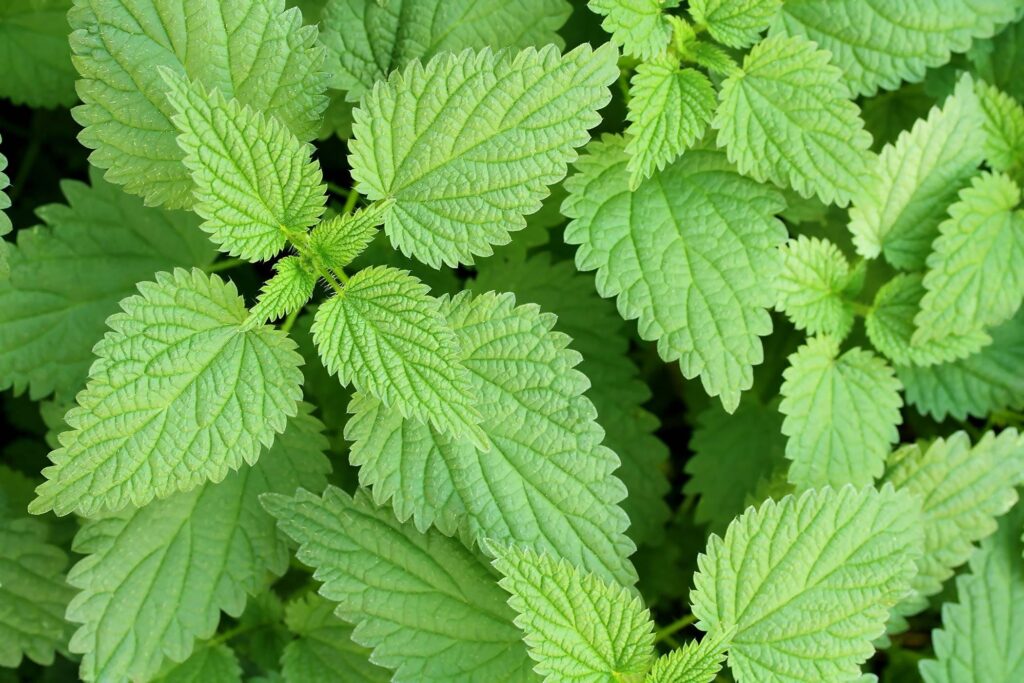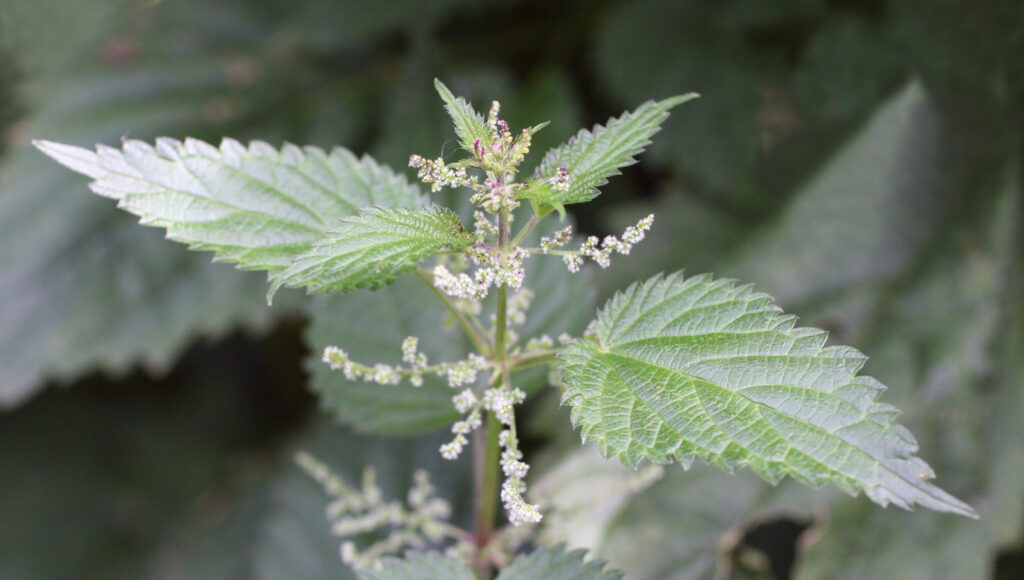Original Sources:
Materia Medica Monthly by Sajah Popham, founder of the School of Evolutionary Herbalism
The Earthwise Herbal Vol. I and II by Matthew Wood

Common Name: Nettle, Stinging Nettle
Latin Name: Urtica dioica, Urtica urens
Family: Urticaceae
Parts Used: Leaves (young shoots in early spring), seeds (late summer), and roots (early autumn). Each of these 3 parts of the plant have radically different properties. This points to the wide range of applications of Nettle.
Geographical Distribution: Stinging Nettle is widely dispersed throughout the world. It prefers to grow in shaded, damp habitats and disturbed soils.
Taste: Salty & Sweet. These 2 tastes lend us some critical information about the properties and uses of Nettle. The salty taste indicates that it contains a high level of minerals. Due to this it is acting upon the sphere of the kidneys and urinary tract. The sweet flavor of Nettle is quite a bit more subtle than the saltiness. Sweetness builds up tissues, strengthens the constitution, and is often used for weakened organ systems due to malnutrition, dryness, or atrophy. These are the primary tastes the leaves of Nettle contain.
Nettle has been used for hundreds, probably thousands of years. Many people around the world have discovered the vast spectrum of properties of Nettle. We see it used all throughout European folk and medical level practices of medicine, as well as throughout North American herbalism, and by some indigenous peoples.
Primary actions of Nettle:
Diuretic: This is one of the primary properties of Nettle. Most people think of diuretics as acting primarily upon the kidneys and urinary tract by increasing water output and urination. But, it’s critical to understand that a diuretic is not only working locally on the kidneys, but systematically on the waters of the body. This is why diuretics have been used to relieve edema in the ankles, ascites in the gut, or drain a puffy swollen arthritic joint. A diuretic is effectively expelling water from the tissues and draining moisture from the body. It is important to understand that pretty much all diuretics will have a constitutionally drying effect.
One thing that is important and interesting about many herbal diuretics, is that they tend to contain high amounts of potassium, which tends to be excreted in relatively high amounts in the urine due to its water solubility. It is common in conventional medicine to give patients with high blood pressure a “loop diuretic” which radically depletes the body’s store of potassium to dangerous levels, which is why they usually always give potassium pills along with the diuretics. Nature in all of her brilliance makes these herbal diuretics which innately have high levels of potassium to replenish what will be depleted through increasing urination. This is true of Nettle and Dandelion leaf (Taraxacum officinale).
Alterative: As a “spring tonic” Nettle has a long standing traditional use as a mild but effective remedy for detoxification. In general, alterative remedies open up the channels of elimination of the body, facilitate in the expulsion of waste products, and adjust or “alter” the metabolic functioning of the body. This includes absorption and distribution of nutrients, as well as the elimination of waste products.
As mentioned above, Nettle is a diuretic, thus we see it having a strong kidney/urinary tract affinity as an alterative, but we also see it having a strong action upon the blood and the skin as well. Its actions upon the blood are two-fold, on the one hand it builds the blood through its rich mineral content and nutrients, and second it helps to cleanse and detoxify the blood of stagnation and accumulation of metabolic wastes. In this way it has been used to provide support for these symptoms: chronic skin conditions, low grade infection, damp accumulation within the tissues, digestive stagnation, acidity in the tissues, and liver stagnation.
Nutritive Tonic: Nettle is one of our most nutritious plants that grows abundantly all over the world. It can be considered both a food and a medicine. It is extremely rich in iron, protein, chlorophyll, vitamin C, dietary fiber, potassium, silica, and calcium, among others. It has classically been an additive to soups and stews to imbue its wide nutrient profile, and many modern day herbalists will make pesto out of it as well. This broad nutrient profile indicates its use in people that are malnourished, thin, weak, pale, emaciated, and lacking in vital nutrients to sustain their body. It strengthens connective tissues, assists in protein metabolism, builds the blood in iron deficiency anemia, and nourishes the body on a cellular level in a quite profound way.
Astringent: Nettle leaves are also a quite reliable tonic astringent for tissues that have become weak and lax. It brings extra tone to the intestines, the uterus, as well as the blood vessels, making it quite useful in conditions such as leaky gut syndrome, uterine bleeding and prolapse, post childbirth, high and low blood pressure, and even internal bleeding. It’s important to consider that the astringent action has a drying effect upon the local tissues.
Rubefacient: This action is sometimes also referred to as “counterirritant.” It is a pretty specific action that not too many plants have, but Nettle is truly the shining star of the rubefacients. This is a topical application of a plant where the local tissues upon contact with the herb are stimulated in a greater level of activity, primarily through an increase in blood flow and circulation. This would be the classic Nettle flogging used in Russian bathhouses and for any daring herbalist to deepen in their relationship with this plant.
Why flog oneself with Nettles you ask? Well through increasing the blood flow to a local area, you bring a flood of fresh oxygenated blood loaded with nutrients, which not only benefits the tissues nutritionally, but also enables stagnated waste products and such to be purged from the tissues to ultimately be eliminated. The rubefacient action is typically used for stiff, tight, swollen, and achy arthritic joints, and sore muscles.
Inflammation Modulating: The last action we see in Nettle is the ability to modulate the body’s inflammation processes. The rich content of chlorophyll cools and alkalizes the tissues. We see this aspect of Nettle widely dispersed throughout the body- from puffy swollen arthritic joints, GI inflammation, and excessive heat in the cardiovascular system, to inflammation in the urinary tract, womb, and prostate gland. This versatility of Nettle makes it applicable in a wide range of different herbal formulas focused on different organ systems.
Physical Organs, Systems and Tissues: These are the primary organs, systems and tissues Nettle has an affinity for.
Kidneys and Urinary Tract (all parts): Here we see Nettle having its major action as a diuretic, draining fluids from the body and increasing urination. It can be used with other herbs as a flushing treatment to purify the waters of the body. The seeds of Nettle have a highly interesting property as a kidney trophorestorative, used whenever there is kidney damage, failure, dialysis, and other major problems in the structure/function of the kidneys.
Blood and Circulation (leaf): Its effects on blood and circulation are broad. On the one hand it helps to build blood and on the other it helps to purify it. It tightens the walls of the arteries and veins and strengthens the connective tissue lining of the vessels as well.
Liver (leaf)- Its effects on the liver include general detoxification and purification of the body, but particularly in regards to protein metabolism and purification of water soluble toxins.
Connective Tissues and Musculoskeletal System (leaf): This affinity works widely throughout the body, from the circulatory system, to the joints, the uterus, hair, skin and nails, the muscles, and even the bones. This is achieved through its nutritive tonic effects as well as the inflammation modulating activity.
Uterus (leaf): Helps to astringe, tonify, and strengthen the womb during pregnancy and post childbirth.
Skin (leaf): The action on the skin is obvious when you touch the live plant, but it has a very different action internally for the skin. In fact, you can think of Nettle being applicable internally for skin conditions that look similar to the reaction you get after touching the live plant!
Prostate Gland (root): The roots of Nettle have a strong affinity for the prostate gland, reducing inflammation, improving urine flow, reducing frequency, and reducing BPH.
Adrenal Glands (seeds): The seeds directly stimulate the adrenals to secrete stimulating hormones such as epinephrine. My teacher told a story where a friend took 1 tbsp in a smoothie and couldn’t sleep for 2 nights, it was so stimulating!
Energetics: Energetics give us a way to distinguish how a specific plant will affect the temperature, moisture, and tonal quality in a person. A plant’s temperature quality can either be warming or cooling. Its moisture quality can either be drying or moistening. Its tonal quality can either be relaxing or tonifying. There are of course plants that can be neutral in a certain quality.
The effect of Nettle upon the temperature quality is that of being cooling.
Its effect upon moisture, like many other herbs, is drying.
Its effect upon the tone of the tissues is tonifying.
Nettle will effectively drain the excess moisture from the tissues and cool down excessive heat. The tonic/astringent effects show its benefit in tissues that have become lax and flaccid and need more tone to them. Nettle increases the vital response of the tissues and organs it has an affinity for. This indicates its use in depressed conditions where the vital force is lowered.
Contraindications: While Nettle is primarily considered a pretty mild and safe remedy for use, there are a few areas in its use to exercise a bit of caution. In general, when dealing with kidney stones, one needs to be particularly cautious especially if the stone is obstructive meaning that it is completely blocking the urinary tract. Acute or chronic kidney disease is very serious and should be overseen by a qualified physician.
The primary side effect one would be most likely to experience with Nettle would be the constitutional drying effects. Signs of this constitutional side effect would be dry mouth, eyes, mucosal membranes, and stool.
There are no known interactions Nettle has with drugs, though one could assume that as a diuretic it would exacerbate the effects of thiazide or loop diuretics.
I absolutely love Nettle because it has helped me to evolve certain parts of myself. In the spring, I love making a delicious soup out of it. I saute onions and garlic on ghee (or avocado oil), until golden. Next I add chopped potatoes, pink salt, and water. Then I boil the potatoes. Once boiled, I add fresh picked nettle leaves, and whatever herbs and spices I’m feeling that day. Finally I blend it and the result is a delicious nutrient-dense soup. I’ll be sharing pictures and the whole recipe in the spring, so stay tuned to this blog!
If you are interested in experiencing the power of this plant for yourself, check out our shop!
See you on the next post,
Patryk Chrzanowski
In-house Herbalist

